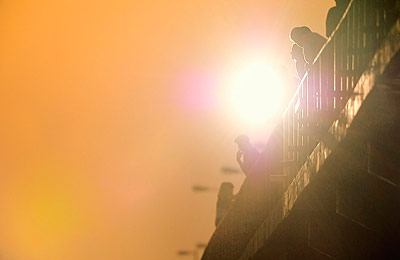Workshop at the Ranch – June 2010 – West Coast Flash
![]() Before I get started on this month’s tutorial I wanted to mention that I have just released my book; The Way I See It … 50 One Page Workshops as an ebook download. Although the hard cover edition of The Way I See It … was very well received, many of you requested a more convenient ebook download. This ebook version is the hard cover coffee table book edition with all the same chapters, large images, technical lessons and stories, and complete camera data with equipment lists. It is less expensive at $29.95. An in-depth book review can be found here
Before I get started on this month’s tutorial I wanted to mention that I have just released my book; The Way I See It … 50 One Page Workshops as an ebook download. Although the hard cover edition of The Way I See It … was very well received, many of you requested a more convenient ebook download. This ebook version is the hard cover coffee table book edition with all the same chapters, large images, technical lessons and stories, and complete camera data with equipment lists. It is less expensive at $29.95. An in-depth book review can be found here
Before I get started on this month’s tutorial I wanted to mention that I have just released my book; The Way I See It … 50 One Page Workshops as an ebook download. Although the hard cover edition of The Way I See It … was very well received, many of you requested a more convenient ebook download. This ebook version is the hard cover coffee table book edition with all the same chapters, large images, technical lessons and stories, and complete camera data with equipment lists. It is less expensive at $29.95. An in-depth book review can be found here
Hope you enjoy The Way I See It … ebook download version. Dave.

West Coast Flash
Hi and welcome to this edition of Workshop at the Ranch. My quest to photograph Sports Action with Speedlights has turned into quite an adventure. April’s Workshop at the Ranch taught how to light a college ice hockey arena using 8 Speedlights. Then in May I lit the USOTC Aquatic Center and some Olympic athletes using just 4 Speedlights. This month I decided to get outdoors and illuminate the biggest sports venue I’ve ever attempted, surfing. That’s right, I wanted to find out if I could illuminate surfers using 8 Nikon SB-900 Speedlights. So grab your boogie board and bongos and let’s see if lighting surfers with Speedlights is possible.
I was not on assignment during the 3 evenings of Speedlight Surfing north of San Diego. Sometimes I just want to find out if an idea in my head is possible to accomplish. I am not a surfing photographer, far from it. I have great respect for those who make their living from this sport and especially those who “light up the action” with flash while riding the ocean waves. That’s right, some photographers illuminate surfers with off camera strobe lighting while floating in the water. Well, such oceanic expertise with Speedlights is not my cup of mango juice, but I have been curious about using my SB-900 Speedlights to light surfers using a more “arena” style lighting arrangement. I also wanted to continue making use of the Nikon camera’s Auto-FP custom setting and combine the ambient outdoor daylight with Speedlight and use a fast shutter sync speed just as I have been doing with indoor arena sports. To achieve enough illumination to do this I used 8 Nikon SB-900 Speedlights mounted on 2 FourSquare Blocks connected together via the FourSquare Hand Grip. This “EightSquare” as I call it, would provide a very substantial single source of off camera flash. The big question was, how far will the light reach? That depends on how bright the available daylight is. I estimated that from the “EightSquare” Speedlight location on the pier to a surfer might be 200-250 feet. By using the wireless Radio Popper PX transmitter and receiver system I could easily be 275 feet or more away from the Speedlights. This triangular arrangement (camera – to subject – to Speedlights) is commonly used for portraiture. My plan was to manually underexpose the ambient light of the general scene, the Pacific Ocean, and add some illumination to the surfer with the single light source of my 8 Speedlights located on the pier that is adjacent to where the surfers are catching waves. A sort of arena surfing set-up. What I didn’t expect was how difficult it would be to photograph surfing without the luxury of shooting 9 frames per second. As with any strobe system a photographer can only make one shot and then wait for the strobe to recycle up to full power again before making another shot. With the SANYO Eneloop rechargeable AA batteries in my SB-900 Speedlights I can make a picture every 2.3 seconds at full power. Even so this still only allows me a single shot to capture the peek action moment after which my surfer would usually finish out the ride. No other sport I have ever experienced required such a precise combination of photographic timing, lighting technology, and perfect environmental conditions (a good surfing wave) in order to achieve a strobed image. A great challenge and a real kick!
|
|
|
|
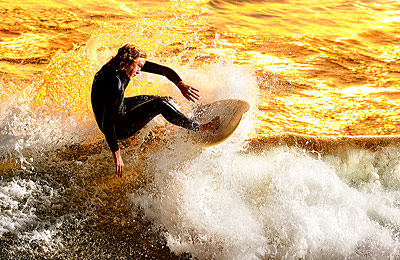 Image #2B Surfer Revealed … Speedlights ON. With the same manual exposure I now turn on the Radio Popper PX Transmitter that is attached to my Nikon SU-800 Commander on my camera’s hotshoe. The 8 Speedlights fire and Travis is revealed from silhouette with light. The combination of the –1.3 stop underexposed background (the golden ocean) and the light from 8 Speedlights certainly gives a very stylized look. All 8 Speedlights are set to Full Power and are in the Remote mode. I have created a Fill Flash, a BIG FILL FLASH, but still just a fill flash. I have combined the underexposed available ambient light of the general scene with flash on my subject that is 175 feet away from the Speedlights. I’m using the camera’s Auto FP custom setting to achieve a fast shutter sync speed of 1/1600 to stop the action and use flash at the same time. As mentioned previously I am using a triangular lighting arrangement between the camera, the Speedlights and the surfer. The distance from myself to the Speedlights is about 225 feet while the distance from the Speedlights to the surfer is about 175 feet. The triangle is completed with the distance from the camera to the surfer being about 200 feet. Nikon D3s, ISO2500, 1/1600 at f6.3, Nikon 600mm with 1.4x teleconverter, WB 8000K, 8 SB-900 Speedlights at Full Power (set via the SU-800 Commander) and are in Remote mode and mounted to the 2 FourSquare Blocks with Hand Grip (an “EightSquare” as I call it), Gitzo Monopod to support the “EightSquare” and a Gitzo Monopod to support the 600mm lens, Radio Popper PX System, Michael Bass Design Fiber Optic Bundles (MBD Bundles), Nikon SU-800 Commander, Lexar 16G Flash Card. Image #2B Surfer Revealed … Speedlights ON. With the same manual exposure I now turn on the Radio Popper PX Transmitter that is attached to my Nikon SU-800 Commander on my camera’s hotshoe. The 8 Speedlights fire and Travis is revealed from silhouette with light. The combination of the –1.3 stop underexposed background (the golden ocean) and the light from 8 Speedlights certainly gives a very stylized look. All 8 Speedlights are set to Full Power and are in the Remote mode. I have created a Fill Flash, a BIG FILL FLASH, but still just a fill flash. I have combined the underexposed available ambient light of the general scene with flash on my subject that is 175 feet away from the Speedlights. I’m using the camera’s Auto FP custom setting to achieve a fast shutter sync speed of 1/1600 to stop the action and use flash at the same time. As mentioned previously I am using a triangular lighting arrangement between the camera, the Speedlights and the surfer. The distance from myself to the Speedlights is about 225 feet while the distance from the Speedlights to the surfer is about 175 feet. The triangle is completed with the distance from the camera to the surfer being about 200 feet. Nikon D3s, ISO2500, 1/1600 at f6.3, Nikon 600mm with 1.4x teleconverter, WB 8000K, 8 SB-900 Speedlights at Full Power (set via the SU-800 Commander) and are in Remote mode and mounted to the 2 FourSquare Blocks with Hand Grip (an “EightSquare” as I call it), Gitzo Monopod to support the “EightSquare” and a Gitzo Monopod to support the 600mm lens, Radio Popper PX System, Michael Bass Design Fiber Optic Bundles (MBD Bundles), Nikon SU-800 Commander, Lexar 16G Flash Card. |
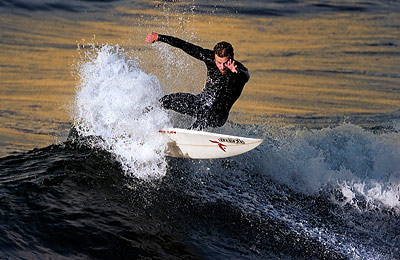 Image #3 West Crest Surfer … Ralph West is a main staple of surfing athleticism at Ocean Beach. He holds the ability to make a dynamic cut out of thin air, … or in this case thin water. Shot at 7:42 pm I manually set my exposure at –1.3 stop under the ambient light conditions and then filled Ralph in with light. The sun has just set but the color in the sky causes some golden reflection on the water behind him and provides a bit of background color. The flash from 8 Speedlights reveals him from being a dark silhouette. The distance from the Speedlights to Ralph is about 200 feet and the illumination is substantial enough to cast his shadow on the white water behind him. Nikon D3s, ISO3200, 1/1250 at f6.3, Nikon 600mm with 1.4x teleconverter, WB 8000K, 8 Speedlights at full power on 2 FourSquares with Grip (“EightSquare”) and 2 Gitzo Monopods, Radio PX system with MBD Bundles, Nikon SU-800 Commander, Lexar 16G Flash Card. Image #3 West Crest Surfer … Ralph West is a main staple of surfing athleticism at Ocean Beach. He holds the ability to make a dynamic cut out of thin air, … or in this case thin water. Shot at 7:42 pm I manually set my exposure at –1.3 stop under the ambient light conditions and then filled Ralph in with light. The sun has just set but the color in the sky causes some golden reflection on the water behind him and provides a bit of background color. The flash from 8 Speedlights reveals him from being a dark silhouette. The distance from the Speedlights to Ralph is about 200 feet and the illumination is substantial enough to cast his shadow on the white water behind him. Nikon D3s, ISO3200, 1/1250 at f6.3, Nikon 600mm with 1.4x teleconverter, WB 8000K, 8 Speedlights at full power on 2 FourSquares with Grip (“EightSquare”) and 2 Gitzo Monopods, Radio PX system with MBD Bundles, Nikon SU-800 Commander, Lexar 16G Flash Card. |
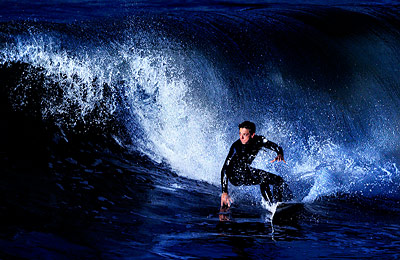 Image #4 Blue Wave Surfer … This image was made about 10 minutes after sunset and the warm color reflection once visible behind Ralph West in the previous image has ended. I have underexposed the general scene by –1.7 stop and I changed my WB to a cooler 4000K. This combination helps enhance the super deep blue color of the water. The light from my 8 Speedlights at Full power reaches Joe Ghio as he begins making a cut. The off camera light from 8 Speedlights illuminates both Joe and the breaking wave while the Auto FP allows me to use a fast shutter sync speed of 1/1000. I have placed the Nikon Warming Gel over the front of 4 of the Speedlights. This reduces the illumination slightly but does add some warm color to Joe’s face. Nikon D3s, ISO3200, 1/1000 at f5.6, Nikon 600mm with 1.4x teleconverter (850mm focal length), WB 4000K, 8 SB-900 Speedlights at Full Power (“EightSquare”) and Warming Gels on 4 of the Speedlights, Radio PX system with MBD Bundles, Nikon SU-800 Commander, Lexar 16G Flash Card. Distance from Speedlights to Joe is about 225 feet. Image #4 Blue Wave Surfer … This image was made about 10 minutes after sunset and the warm color reflection once visible behind Ralph West in the previous image has ended. I have underexposed the general scene by –1.7 stop and I changed my WB to a cooler 4000K. This combination helps enhance the super deep blue color of the water. The light from my 8 Speedlights at Full power reaches Joe Ghio as he begins making a cut. The off camera light from 8 Speedlights illuminates both Joe and the breaking wave while the Auto FP allows me to use a fast shutter sync speed of 1/1000. I have placed the Nikon Warming Gel over the front of 4 of the Speedlights. This reduces the illumination slightly but does add some warm color to Joe’s face. Nikon D3s, ISO3200, 1/1000 at f5.6, Nikon 600mm with 1.4x teleconverter (850mm focal length), WB 4000K, 8 SB-900 Speedlights at Full Power (“EightSquare”) and Warming Gels on 4 of the Speedlights, Radio PX system with MBD Bundles, Nikon SU-800 Commander, Lexar 16G Flash Card. Distance from Speedlights to Joe is about 225 feet. |
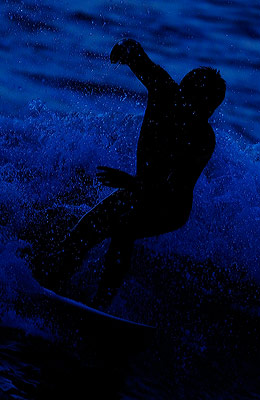 Image #5A Ice Blue Surfer … Speedlights OFF. These next two images illustrate what the Speedlights are doing, a sort of before and after comparison. I have underexposed the general scene –1.7 stop which leaves surfer Julian Mullins in dark silhouette. I again used a cool WB of 4000K to make the ocean look colder and deeper blue. Nikon D3s, ISO4000, 1/1000 at f6.7, Nikon 600mm lens with Nikon TC17E 1.7x teleconverter (the 1.7x makes a 1,020mm focal length), Gitzo Monopod for the lens, WB 4000K, No Speedlights, Lexar 16G Flash Card. Image #5A Ice Blue Surfer … Speedlights OFF. These next two images illustrate what the Speedlights are doing, a sort of before and after comparison. I have underexposed the general scene –1.7 stop which leaves surfer Julian Mullins in dark silhouette. I again used a cool WB of 4000K to make the ocean look colder and deeper blue. Nikon D3s, ISO4000, 1/1000 at f6.7, Nikon 600mm lens with Nikon TC17E 1.7x teleconverter (the 1.7x makes a 1,020mm focal length), Gitzo Monopod for the lens, WB 4000K, No Speedlights, Lexar 16G Flash Card. |
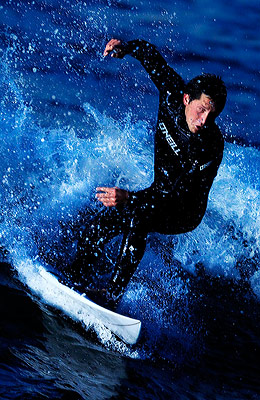 Image #5B Ice Blue Surfer … Speedlights ON. With the 8 Speedlights at Full power Julian is revealed from silhouette. I have again placed 4 Warming Gels over 4 of the Speedlights to add some warm skin tone to his face and hands. The cool WB of 4000K and –1.7 stop underexposed general scene enhances the deep blue ocean. The off camera light illuminates the spray of water to the point of almost looking like he is surfing through ice. Nikon D3s, ISO4000, 1/1000 at f6.7, Nikon 600mm lens with 1.7x teleconverter (1,020mm), Gitzo Monopod for the lens, WB 4000K, 8 SB-900 Speedlights at Full power 4 with warming gels, “EightSquare,” Grip and Gitzo Monopod for the EightSquare, Radio Popper PX system with MBD Bundles, Nikon SU-800 Commander, Lexar 16G Flash Card. Both these images were shot about 15 minutes after sunset. Distance from Speedlights to surfer is about 200 feet. Image #5B Ice Blue Surfer … Speedlights ON. With the 8 Speedlights at Full power Julian is revealed from silhouette. I have again placed 4 Warming Gels over 4 of the Speedlights to add some warm skin tone to his face and hands. The cool WB of 4000K and –1.7 stop underexposed general scene enhances the deep blue ocean. The off camera light illuminates the spray of water to the point of almost looking like he is surfing through ice. Nikon D3s, ISO4000, 1/1000 at f6.7, Nikon 600mm lens with 1.7x teleconverter (1,020mm), Gitzo Monopod for the lens, WB 4000K, 8 SB-900 Speedlights at Full power 4 with warming gels, “EightSquare,” Grip and Gitzo Monopod for the EightSquare, Radio Popper PX system with MBD Bundles, Nikon SU-800 Commander, Lexar 16G Flash Card. Both these images were shot about 15 minutes after sunset. Distance from Speedlights to surfer is about 200 feet. |
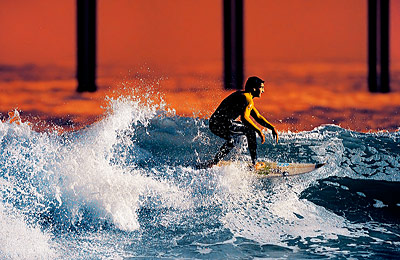 Image #6 Red Pier Surfer … The second evening offered a terrific red sky and ocean against the outer pylons of the pier just before sunset. This color lasted only about 2 minutes. Although the waves were rather minimal during that brief colorful time frame Kirk made a great effort to catch a wave so I could make this picture that combined the ambient light of the general scene (the background of red sky/ocean) and illumination from the Speedlight. Despite less than optimal surfing conditions the athletes thought this was still a “cool cool pic.” I intentionally underexposed red sky and red ocean (the general scene) by about –1.7 stop to deepen the red. Kirk would be just a dark silhouette, like the pier pylons in the distance without the 8 Speedlights doing their job of filling him in with light. He surfs towards Shawn who is standing on the pier holding the “EightSquare” of Speedlights. Nikon D3s, ISO3200, 1/1000 at f6.3, Nikon 600mm lens with 1.4x teleconverter (850mm), WB 5000K, 8 SB-900 Speedlights at full power, “EightSquare”, Radio PX system with MBD Bundles, Nikon SU-800 Commander, Lexar 16G Flash Card. Distance from Speedlights to Kirk is about 165 feet. Distance from Kirk to me is about 285 feet. Distance from me to Speedlights is about 285 feet. Image #6 Red Pier Surfer … The second evening offered a terrific red sky and ocean against the outer pylons of the pier just before sunset. This color lasted only about 2 minutes. Although the waves were rather minimal during that brief colorful time frame Kirk made a great effort to catch a wave so I could make this picture that combined the ambient light of the general scene (the background of red sky/ocean) and illumination from the Speedlight. Despite less than optimal surfing conditions the athletes thought this was still a “cool cool pic.” I intentionally underexposed red sky and red ocean (the general scene) by about –1.7 stop to deepen the red. Kirk would be just a dark silhouette, like the pier pylons in the distance without the 8 Speedlights doing their job of filling him in with light. He surfs towards Shawn who is standing on the pier holding the “EightSquare” of Speedlights. Nikon D3s, ISO3200, 1/1000 at f6.3, Nikon 600mm lens with 1.4x teleconverter (850mm), WB 5000K, 8 SB-900 Speedlights at full power, “EightSquare”, Radio PX system with MBD Bundles, Nikon SU-800 Commander, Lexar 16G Flash Card. Distance from Speedlights to Kirk is about 165 feet. Distance from Kirk to me is about 285 feet. Distance from me to Speedlights is about 285 feet. |
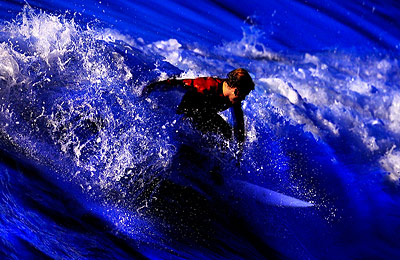 Image #7 West Wave … By the final evening these guys were really into making pictures and continued to surf even though it was 45 minutes after sunset and nearly pitch dark to the naked eye. Ralph caught the last wave of the 3 evening project at 8:25 pm and I made this “moody blue” picture. At ISO5000 and 1/20 of a second at f5.6 this image does not make use of the Auto FP mode for fast shutter sync speeds, but it does make for a very different image of surfing. This super stylized picture using a slow shutter with rear curtain sync and Speedlights got enthusiastic cheers from folks standing next to me on the Ocean Beach Pier when it appeared on the D3s camera’s LCD screen. Nikon D3s, ISO5000, 1/20 at f5.6, Nikon 600mm lens, WB 3030K, 8 Nikon SB-900 Speedlights all with warming gels and at 1/8 power output, Radio PX system with MBD Bundles, Nikon SU-800 Commander, Lexar 16G Flash Card. The non-detectable ambient light is made visible by using ISO5000 and the extremely slow shutter speed of 1/20 with f5.6. The “flash” from the Speedlights freezes the motion of the white water and Ralph’s upper body. It had become so dark that only 1/8 power was needed to illuminate Ralph at a distance of about 165 feet from the Speedlights. Image #7 West Wave … By the final evening these guys were really into making pictures and continued to surf even though it was 45 minutes after sunset and nearly pitch dark to the naked eye. Ralph caught the last wave of the 3 evening project at 8:25 pm and I made this “moody blue” picture. At ISO5000 and 1/20 of a second at f5.6 this image does not make use of the Auto FP mode for fast shutter sync speeds, but it does make for a very different image of surfing. This super stylized picture using a slow shutter with rear curtain sync and Speedlights got enthusiastic cheers from folks standing next to me on the Ocean Beach Pier when it appeared on the D3s camera’s LCD screen. Nikon D3s, ISO5000, 1/20 at f5.6, Nikon 600mm lens, WB 3030K, 8 Nikon SB-900 Speedlights all with warming gels and at 1/8 power output, Radio PX system with MBD Bundles, Nikon SU-800 Commander, Lexar 16G Flash Card. The non-detectable ambient light is made visible by using ISO5000 and the extremely slow shutter speed of 1/20 with f5.6. The “flash” from the Speedlights freezes the motion of the white water and Ralph’s upper body. It had become so dark that only 1/8 power was needed to illuminate Ralph at a distance of about 165 feet from the Speedlights. |
|
|
I hope you have enjoyed and learned from this article. This Speedlight Surfing project was a challenging experiment for me with many lessons learned that will aid me in accomplishing future jobs and projects. I encourage you all to test your equipment’s capabilities and push yourself in an effort to learn.
See you next time as my summer quest for Sports Action Speedlight images continues here on Workshop at the Ranch. Adios. Dave
Here is a lot of equipment that I am using to make these Sports Action Speedlight images. I thought it might be helpful to mention where to acquire these items.
The FourSquare and all FourSquare accessories: www.lightwaredirect.com
The Lightwalker II roll-aboard case (soon to be available): www.lightwareinc.com or any camera store that carries the Lightware brand.
Radio Popper PX Transmitters and PX Receivers: www.radiopopper.com
Michael Bass Designs Fiber Optic Bundle (explained in April and May articles): www.michaelbassdesigns.com
Manfroto (formally Bogen): #155 Double Ball Joint Head and the 5/8-3/8 Rapid Adapters: available at Robert’s Imaging in Indianapolis 800-726-5544 www.robertsimaging.com
Thank you for hanging in there to the end. Hope you enjoyed the article and learned something new.


